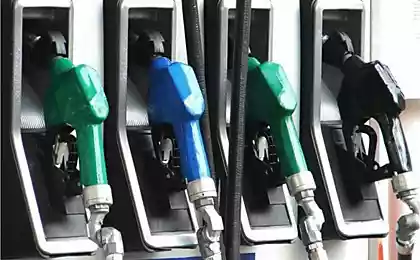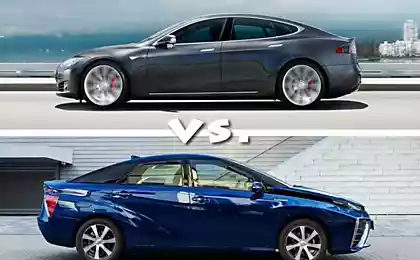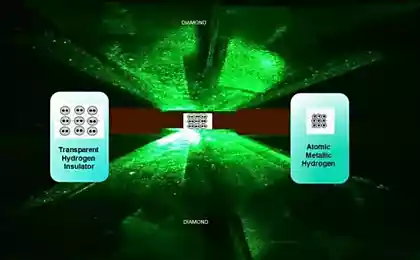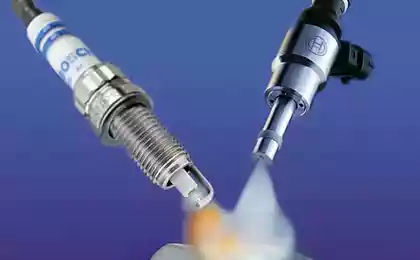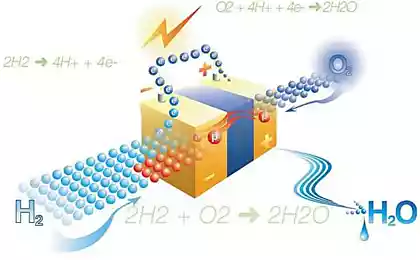502
Hydrogen instead of gasoline
The main danger for the ecology of the planet is continuously growing fleet of vehicles that use derivatives of oil refining as a fuel. In major cities such as Moscow, automobile exhausts account for up to 90 percent of all atmospheric pollution. Yeah last time on the streets we see more electric vehicles and rejoice. But it is important to remember that electricity is also produced mainly by combustion of fossil fuels. Is there a way out?

If anyone has not noticed, we are witnessing the decline of the era of hydrocarbons. Quietly and without much fanfare. Toyota has announced the start of mass production of the budget version of sedan Mirai, which translated from Japanese means "future." It would seem — what future! But for those who still do not know reported that the 153-strong Toyota Mirai is by far the most environmentally friendly. The car has no internal combustion engine, and therefore it does not use traditional fuels.
In fact, it is an electric car that don't need plugging in. Mirai generates electricity on Board and its engine has a crazy efficiency 83%! For comparison, the efficiency of the most advanced internal combustion engine (ice) is more than two times lower. The secret of success is hydrogen.
Attempts to use this gas as fuel were made at the end of the last century. However, the high temperature combustion of the hydrogen quickly disabling the pistons and valves of the intake system, and redone to work "under the hydrogen" engine were too expensive.
Progress has taken a different path. Mirai feeds the motor current, like Tesla, which is produced on Board the vehicle during the chemical reaction coming from the two special tanks of hydrogen sucked from the ambient air oxygen. Briefly, the principle of operation is as follows.

In the fuel cell is fed hydrogen reacts with the anode, on the other hand, the cathode is fed with oxygen. A chemical reaction in which hydrogen atoms are divided into electrons and protons. The electrons go to the grid and the protons combine with oxygen, forming a simple water.
Water should drain from the tank accumulation. The resulting direct current is supplied to the transmitter, where its power increases to 650 volts, and the current becomes alternating. It powers not only the motor, but also located in the trunk of a conventional Nickel-metal-hybrid battery: it is connected in the case where the vehicle requires maximum acceleration. To disperse hundreds of 9 seconds and a top speed limited to 175 kilometers per hour. Mileage: 650 miles.
The same model and Honda is promoting its FCV sedan will also be the serial in this year. The development of even more practical Honda sedan accommodates five people instead of four at Mirai. Engine power from FCV by 23 horsepower more, and more mileage. And then there's the Koreans are threatening to overtake the Japanese with his crossover ix35 Fuel Cell, increasing its mileage to 850 kilometers. Enthusiasts of environmentally friendly transport is ready to blow victory. However, there are a few "buts".
The first — the cost. "Ogorodniki" cost about 60 thousand dollars, but, for example, in Japan the government subsidizes the purchase of a clean car it would be about 35 thousand dollars. Much less than the cost of a Tesla S is about 80 thousand dollars in the United States. The fuel-saving difficult: a kilogram of hydrogen costs 9-10 euros. That is, as much as and petrol in Europe per kilometre.
The second is a small network of petrol stations, although they strenuously are under construction in Japan and California. But the world is actively conducting research on the production of cheap hydrogen, and soon the clean energy source will never end. published
Source: altenergiya.ru/vodorod/vodorod-vmesto-benzina.html

If anyone has not noticed, we are witnessing the decline of the era of hydrocarbons. Quietly and without much fanfare. Toyota has announced the start of mass production of the budget version of sedan Mirai, which translated from Japanese means "future." It would seem — what future! But for those who still do not know reported that the 153-strong Toyota Mirai is by far the most environmentally friendly. The car has no internal combustion engine, and therefore it does not use traditional fuels.
In fact, it is an electric car that don't need plugging in. Mirai generates electricity on Board and its engine has a crazy efficiency 83%! For comparison, the efficiency of the most advanced internal combustion engine (ice) is more than two times lower. The secret of success is hydrogen.
Attempts to use this gas as fuel were made at the end of the last century. However, the high temperature combustion of the hydrogen quickly disabling the pistons and valves of the intake system, and redone to work "under the hydrogen" engine were too expensive.
Progress has taken a different path. Mirai feeds the motor current, like Tesla, which is produced on Board the vehicle during the chemical reaction coming from the two special tanks of hydrogen sucked from the ambient air oxygen. Briefly, the principle of operation is as follows.

In the fuel cell is fed hydrogen reacts with the anode, on the other hand, the cathode is fed with oxygen. A chemical reaction in which hydrogen atoms are divided into electrons and protons. The electrons go to the grid and the protons combine with oxygen, forming a simple water.
Water should drain from the tank accumulation. The resulting direct current is supplied to the transmitter, where its power increases to 650 volts, and the current becomes alternating. It powers not only the motor, but also located in the trunk of a conventional Nickel-metal-hybrid battery: it is connected in the case where the vehicle requires maximum acceleration. To disperse hundreds of 9 seconds and a top speed limited to 175 kilometers per hour. Mileage: 650 miles.
The same model and Honda is promoting its FCV sedan will also be the serial in this year. The development of even more practical Honda sedan accommodates five people instead of four at Mirai. Engine power from FCV by 23 horsepower more, and more mileage. And then there's the Koreans are threatening to overtake the Japanese with his crossover ix35 Fuel Cell, increasing its mileage to 850 kilometers. Enthusiasts of environmentally friendly transport is ready to blow victory. However, there are a few "buts".
The first — the cost. "Ogorodniki" cost about 60 thousand dollars, but, for example, in Japan the government subsidizes the purchase of a clean car it would be about 35 thousand dollars. Much less than the cost of a Tesla S is about 80 thousand dollars in the United States. The fuel-saving difficult: a kilogram of hydrogen costs 9-10 euros. That is, as much as and petrol in Europe per kilometre.
The second is a small network of petrol stations, although they strenuously are under construction in Japan and California. But the world is actively conducting research on the production of cheap hydrogen, and soon the clean energy source will never end. published
Source: altenergiya.ru/vodorod/vodorod-vmesto-benzina.html


